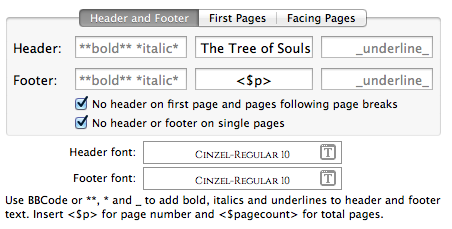
If you want a little more control over your TOC, you can designate a specific page in the Scrivener Binder as your book's TOC. These settings control the automatically generated HTML Scrivener table of contents. This is where you tell Scrivener whether it should include an NCX flat TOC, whether or not to automatically generate an HTML TOC, and if you want the contents centered. Then, in the COMPILE > LAYOUT section, you can define the settings for the automatically generated table of contents. You can also define breaks in the COMPILE > CONTENTS section by clicking the “Page Break Before” checkbox for any document or folder in your book. You can define where those breaks are in the COMPILE > SEPARATORS section by telling Scrivener when to set a break between files and folders. Scrivener will automatically generate a table of contents by looking for section breaks in your book. Define section breaks for your table of contents. Which leads us to the next type of TOC on our list. To do that you need to provide readers with a well-formatted and organized table of contents.

#SCRIVENER 3 INDEX HOW TO#
BackMatter - About the author page, how to get the next book, footnotes.Ī good book allows a reader to easily navigate to these sections and all the major subsections beneath them.Body - Sections, Chapters, and Sub chapters.Front matter - Title, Copyright, Dedication, Table of Contents.Most books are organized into three primary sections: In Scrivener, and other than titles, you have little control over how a NCX TOC renders. But there’s a better way.įirst, let's take a look at your book. I say “supposed to” and “best chance” because there are forums filled with authors tweaking their table of contents in Word or Sigil or some other eBook compiler, trying to force the NCX TOC to come out just right. To give the NCX automatically generated table of contents its best shot at turning out correctly, nest your book’s folders like this: Heading 3 - Sub chapter folder name title.How NCX generates TOC headings.Ī Scrivener NCX table of contents is supposed to generate navigation links to three major parts of your book: So, a table of contents that uses page numbers won't work. Tilt your kindle, iPad or mobile device vertical or horizontal and the "length" of your book changes again. Change the text size and the length changes. The number of pages in your eBook changes from one type of device to another. But unlike print books, NCX TOCs, as well as other types of eBook TOCs, don't list page numbers. NCX stands for Navigation Control file for XML.Īn NCX "table of contents" helps readers find their way around your book. What the heck is an NCX table of contents? A manually created Scrivener table of contents for ebook (Kindle).A manually created Scrivener table of contents for print.

An automatically generated HTML table of contents.An automatically generated NCX flat list of sections and chapters.

Scrivener allows you to take advantage of three to four, depending on how you look at it, types of tables of contents. What you name folders, subfolders and documents determines what labels are in a table of contents. In that way, they're much like Internet hyperlinks.

These links let the reader go directly to a particular spot in the book. Table of contents are usually handled by a reader's reading device using links. But a TOC is at the beginning of your book and it helps readers find and navigate to major sections and chapters.


 0 kommentar(er)
0 kommentar(er)
